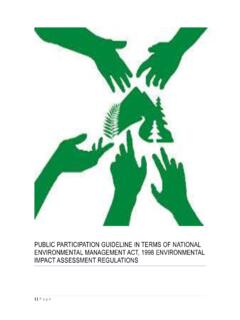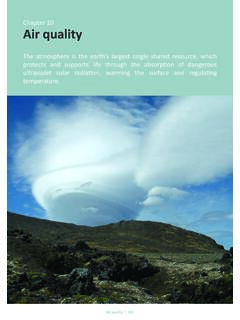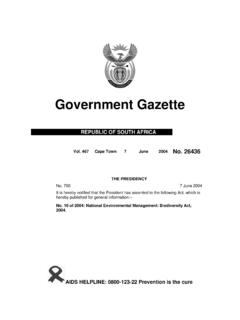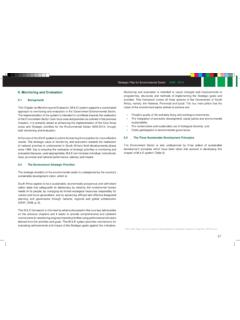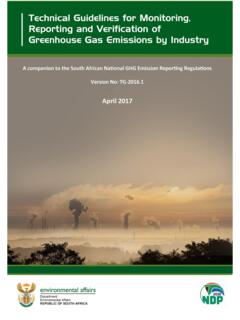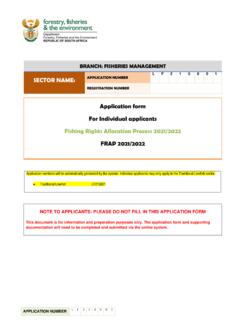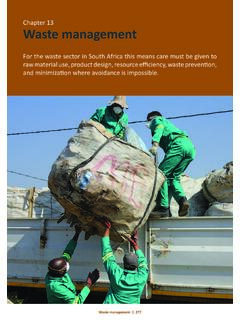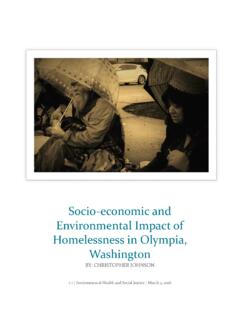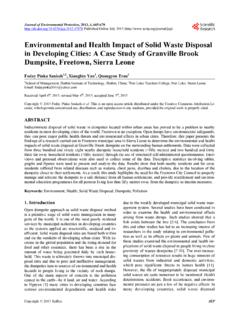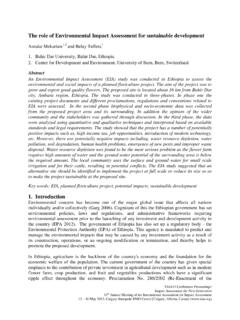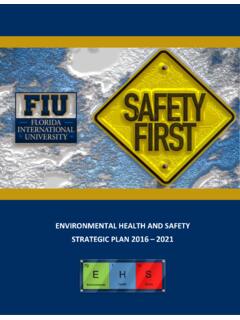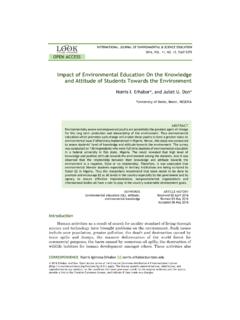Transcription of ENVIRONMENTAL IMPACT ASSESSMENT AND …
1 Suggested citation: Department of ENVIRONMENTAL Affairs, 2014, ENVIRONMENTAL IMPACT ASSESSMENT and Management Strategy for South Africa (Draft). The analysis and recommendations of this Report do not necessarily reflect the views of the Department of ENVIRONMENTAL Affairs. The recommendations do not necessarily carry the full support of all the sectors represented. Errors or omissions found subsequent to printing will be corrected in the online version at Logo design by Kotie Geldenhuys. Cover photograph provided by City of Tshwane. Photographer unknown. Photographed from the Union Buildings towards the city. Project Steering Committee: Department of ENVIRONMENTAL Affairs, the Department of Water Affairs, Provincial Competent Authorities and Local Authorities; Non-Governmental Organisations; ENVIRONMENTAL Law Association; Chamber of Mines; Business Unity South Africa (BUSA); the South African Local Government Association (SALGA); the Academic sector and the South African affiliate of the International Association for IMPACT ASSESSMENT .
2 Project Coordinator: Madeleine Oosthuizen The Project Steering Committee is established by the Department of ENVIRONMENTAL Affairs (DEA) for identified sectors to collaborate on a strategy for IMPACT ASSESSMENT and management in South Africa. 1 Acknowledgements Acknowledgement to the EIAMS Project Steering Committee members who devoted their time, skills and energy on a continuous basis over the past 4 years. The contributions of many other individuals from the various sectors, whose comments were reported to the PSC by their sector representatives, are gratefully acknowledged. Angela Andrews NGO Legal Resources Centre (LRC) (Theme 1 Coordinator) Amanda Britz National Department of ENVIRONMENTAL Affairs Janet Bodenstein City of Cape Town:ERM Desmond D Sa NGO SDCEA Carol Dixon BUSA Chantal Engelbrecht National Department of ENVIRONMENTAL Affairs Dee Fisher National Department of ENVIRONMENTAL Affairs Chris Galliers NGO WESSA (Theme 1 Coordinator) Paul Hardcastle WC Department of ENVIRONMENTAL Affairs and Development Planning (Theme 1 Coordinator) Richard Hill Academic Sector (Theme 1 Coordinator) Sibusisiwe Hlela National Department of ENVIRONMENTAL Affairs Mercia Komen NGO Sector Matome Makwela Chamber of Mines Betty Mdala National Department of ENVIRONMENTAL Affairs Adele Meyer Business South Africa (BUSA)
3 William MNgoma KZN Department of Agriculture and ENVIRONMENTAL Affairs Simon Moganetsi National Department of ENVIRONMENTAL Affairs Victor Mongwe Limpopo Department of Economic Development, Environment and Tourism Stephinah Mudau Chamber of Mines Dashentha Naidoo Department of Water Affairs Sean O Beirne EAP (SES) (Chairperson: Conflict Resolution Committee and pro-bono facilitator) Madeleine Oosthuizen DEA: Project Coordinator and Chairperson Koos Pretorius NGO Federation of Sustainable Environment (FSE) (Theme 2 Coordinator) Dhiraj Rama Association of Cementitious Material Producers (ACMP) Francois Retief IAIAsa (Theme 1 Coordinator) John Scotcher BUSA Richard Summers ENVIRONMENTAL Law Association (ELA) (Theme 1 Coordinator and pro-bono facilitator) Chumisa Thengwa eThekwini Municipality Gerrie van Schalkwyk IAIAsa (Theme 2 Coordinator) The report is the product of the collaboration involving the members Project Steering Committee, the sectors they represent and input from the Advisory and Reference Groups.
4 Numerous individuals, colleagues and professionals provided information and expert opinion, and are acknowledged for their contribution. In particular Jenny Hall Johan Nel Jenny Pope Peter Croal Angus Morrison-Saunders - Enviro Council , SA - North West University, SA - Australia - Canada - Australia Gerard van Weele Susie Brownlie Mary-Jane Morris Ingrid Coetzee Charl de Villiers - South Africa - Cape Town - Cape Town - Cape Town - Botanical Society of SA 2 Special mention is made of the small task team for considering comments, relevant amendments to report and final editing of draft strategy. These volunteers generously gave their time over and above their active contribution on the Steering Committee. Paul Hardcastle Richard Hill final editor Mercia Komen Sean O Beirne Francois Retief Richard Summers The team included Madeleine Oosthuizen, Project Coordinator and author of the first draft ENVIRONMENTAL IMPACT ASSESSMENT and Management Strategy.
5 Appreciation goes to the authors of the eleven Sub-Theme Reports EnAct International: Ingrid Coetzee, Glendyr Nel DEA: Madeleine Oosthuizen MLA-Sustainability Matters: Marlene Laros NGO Sector: Mercia Komen Phelamanga Projects: Rod Bulman SE Solutions (Pty) Ltd: Sean O Beirne SSI ENVIRONMENTAL : Mark Freeman, Janet Loubser, Gillian Maree, Malcolm Roods, Gerard van Weele The Green Connection: Christy Bragg, Basier Dramat, Liz Mcdaid, Lynette Munro, Roshan Stanford And Theme Reports Council for Scientific and Industrial Research (CSIR): Benita de Wet, Michelle Audouin, Douglas Trotter, Marius Claassen, Karen Nortje uKhozi Environmentalists: Ken Smith, Marita Oosthuizen, Jaco Grundling, Elbie Oosthuizen 3 Definition of Terms Adaptive management Adaptive management strives to eliminate, reduce or rectify unforeseen or adverse impacts through corrective action.
6 It responds to evidence of impacts and continually monitors and assesses the efficacy of changes in management action, which achieves best practice and continual improvement. Alignment The proper positioning of parts in relation to each other Accessible Able to be easily obtained or used; easily understood or appreciated. Also means removing the barriers that prevents access to websites and electronic documentation by people with disabilities. Biodiversity offsets Conservation activities that are designed to give biodiversity benefits to compensate for losses. These 'averted loss offsets' aim to reduce or stop biodiversity loss ( future habitat degradation) in areas where this is predicted. The offset should result in the protection of equal or more ENVIRONMENTAL assets, measured in size, type and function. This form of ecological compensation is sustained over time.
7 Building Platform Building Platforms are the main objectives of the ENVIRONMENTAL IMPACT ASSESSMENT and Management Strategy, and are expressed as desired outcomes. Capacity Building Building abilities, relationships and values that will enable organisations, institutions and individuals to improve their performance and achieve sustainability. It includes influencing collective and individual beliefs, values and practices to alter behaviour and performance. Civil Society Civil society is the sphere of organizations and/or associations of organizations located between the family, the state, the government of the day, and the prevailing economic system, in which people with common interests associate voluntarily. Amongst those organizations, they may have common, competing or conflicting values and interests. Source: National Development Agency ( ) Constitution The Constitution of South Africa Coordination The organization of different elements of a complex body or activity to enable them to work together effectively.
8 Corporate governance Refers broadly to the rules, processes, or laws by which businesses are operated, regulated, and controlled. Credible spatial planning frameworks SDFs that are informed by an SEA or EMF that was compiled during the SDF planning process Corporate Social Investment (CSI) Corporate Social Investment encompasses projects that are external to the normal business activities of a company and not directly for purposes of increasing company profit. These projects have a strong developmental approach and utilise company resources (time, money and/or expertise) to benefit and uplift communities and are not primarily driven as marketing initiatives. 4 Desired State of the Environment Reports The main purpose of this category of reporting is to determine a desired state for the environment and to contrast this with the current (status quo) state of the environment.
9 These may include reporting by using ENVIRONMENTAL management tools and instruments such as ENVIRONMENTAL outlook reporting, sustainability-led SEAs, EMF s or other spatial tools. Discretion Refers to a careful, cautious, good judgement in decision-making which is guided by clear parameters and defined criteria. Ecologically sustainable development Sustainable development implies the selection and implementation of a development option which allows for appropriate and justifiable social and economic goals to be achieved without compromising the natural system on which it is based. Sustainable development therefore ensures that non-negotiable ENVIRONMENTAL thresholds are maintained, ecosystems are sustained, effective climate change mitigation and adaption is facilitated, and natural resources are used effectively. A movement to a green and low-carbon economy is required.
10 Fit for purpose The ENVIRONMENTAL Management instrument or tool is appropriate to the nature, scale and scope of a proposal or activity and the level of ASSESSMENT required to enable defensible, informed and impartial ENVIRONMENTAL decision making; the instrument or tool is appropriate to the significance of anticipated impacts, providing for a scoped yet comprehensive analysis to enable the identification, prediction, ASSESSMENT and evaluation of the potential and actual ENVIRONMENTAL impacts and the risks of proposals and activities; and will enable the consideration of alternatives and options for mitigation, with a view to minimising negative impacts, maximising benefits and promoting compliance with the national ENVIRONMENTAL management principles in section 2 of NEMA. Information and management systems Information Systems record and store information.
